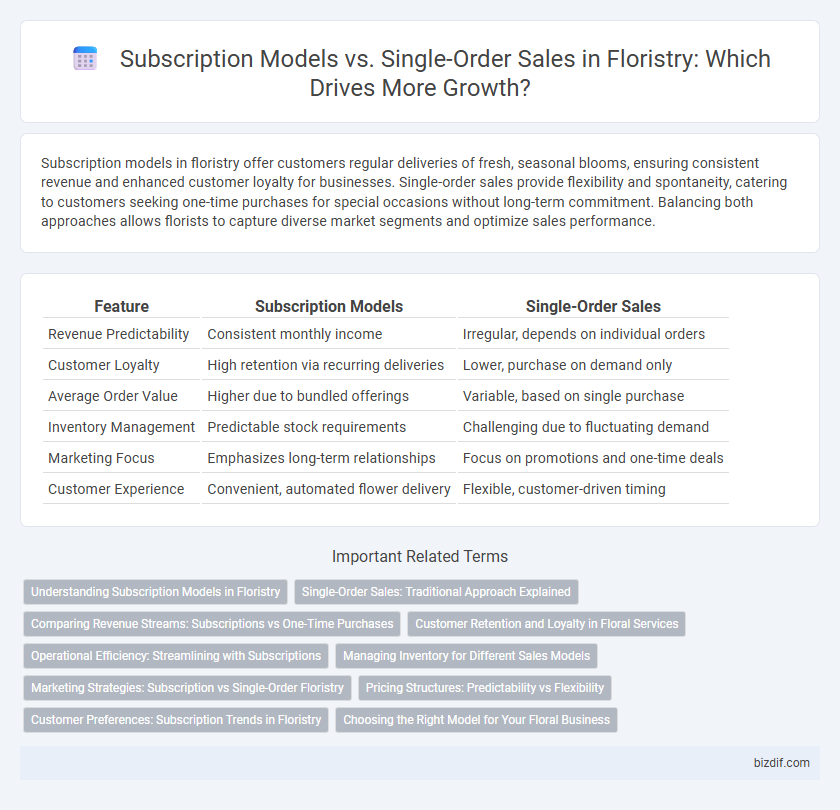Subscription models in floristry offer customers regular deliveries of fresh, seasonal blooms, ensuring consistent revenue and enhanced customer loyalty for businesses. Single-order sales provide flexibility and spontaneity, catering to customers seeking one-time purchases for special occasions without long-term commitment. Balancing both approaches allows florists to capture diverse market segments and optimize sales performance.
Table of Comparison
| Feature | Subscription Models | Single-Order Sales |
|---|---|---|
| Revenue Predictability | Consistent monthly income | Irregular, depends on individual orders |
| Customer Loyalty | High retention via recurring deliveries | Lower, purchase on demand only |
| Average Order Value | Higher due to bundled offerings | Variable, based on single purchase |
| Inventory Management | Predictable stock requirements | Challenging due to fluctuating demand |
| Marketing Focus | Emphasizes long-term relationships | Focus on promotions and one-time deals |
| Customer Experience | Convenient, automated flower delivery | Flexible, customer-driven timing |
Understanding Subscription Models in Floristry
Subscription models in floristry provide customers with regular flower deliveries, offering convenience and a steady revenue stream for florists. These models leverage customer retention by delivering fresh, seasonal arrangements on a weekly or monthly basis, enhancing brand loyalty and predictable cash flow. Data shows subscription services increase customer lifetime value by up to 30% compared to single-order sales, which rely on one-time purchases without guaranteed recurring income.
Single-Order Sales: Traditional Approach Explained
Single-order sales in floristry represent a traditional purchasing model where customers buy bouquets or floral arrangements on an as-needed basis without ongoing commitments. This approach offers flexibility for buyers seeking one-time gifts or event-specific flowers, appealing to diverse occasions such as birthdays, weddings, or funerals. Florists benefit from immediate revenue with each transaction, but face challenges in predicting demand and maintaining consistent cash flow compared to subscription-based models.
Comparing Revenue Streams: Subscriptions vs One-Time Purchases
Subscription models in floristry generate predictable monthly revenue, enhance customer retention, and increase lifetime value through recurring orders of fresh floral arrangements. Single-order sales provide immediate cash flow and cater to spontaneous purchases or special occasions but lack the consistent income and customer loyalty benefits of subscriptions. Comparing revenue streams, subscriptions drive steady, scalable growth while one-time purchases require higher volume to match subscription profitability.
Customer Retention and Loyalty in Floral Services
Subscription models in floral services significantly enhance customer retention by offering regular, scheduled deliveries that create consistent touchpoints and foster long-term loyalty. Single-order sales often result in one-time purchases with less opportunity for ongoing engagement, limiting brand connection and repeat business. By providing customizable subscription plans, florists can ensure continuous customer satisfaction and increase lifetime value through personalized floral arrangements and exclusive member benefits.
Operational Efficiency: Streamlining with Subscriptions
Subscription models in floristry enhance operational efficiency by enabling predictable inventory management and reducing waste through scheduled deliveries. Consistent orders from subscribers allow florists to optimize supply chains and allocate resources more effectively compared to single-order sales. Streamlining workflows with automated processes in subscription services minimizes manual input and improves overall profitability.
Managing Inventory for Different Sales Models
Subscription models in floristry require precise inventory forecasting to ensure fresh, seasonal blooms are consistently available for scheduled deliveries, minimizing waste and maximizing freshness. Single-order sales demand flexible inventory management to accommodate fluctuating demand and spontaneous orders, often necessitating rapid procurement and adjustment. Implementing dynamic inventory systems that track flower shelf life and customer preferences can optimize stock levels across both sales models, balancing supply with demand efficiently.
Marketing Strategies: Subscription vs Single-Order Floristry
Subscription floristry leverages customer retention through personalized, recurring deliveries, increasing lifetime value and enabling precise inventory forecasting, while single-order sales focus on capturing impulse purchases and seasonal spikes with targeted, promotional campaigns. Marketing strategies for subscriptions emphasize ongoing engagement, exclusive offers, and convenience, enhancing brand loyalty and predictable revenue streams. Single-order approaches rely on high-impact advertising, limited-time discounts, and occasion-based messaging to maximize immediate sales and attract diverse customer segments.
Pricing Structures: Predictability vs Flexibility
Subscription models in floristry offer predictable pricing structures, enabling customers to budget for regular flower deliveries at a fixed cost, which enhances customer loyalty and steady revenue streams for businesses. Single-order sales provide greater pricing flexibility, accommodating one-time purchases with variable pricing based on seasonal availability, flower types, and order size. Florists must balance these pricing strategies to attract diverse customer segments seeking either consistent value or customized floral experiences.
Customer Preferences: Subscription Trends in Floristry
Subscription models in floristry cater to growing customer preferences for convenience and regular fresh flower deliveries, often boosting customer retention and lifetime value compared to single-order sales. Data indicates a significant rise in monthly floral subscription services, reflecting consumer demand for curated, seasonal arrangements without the hassle of repeated ordering. This trend highlights a shift towards experience-driven purchasing, with florists leveraging subscription plans to secure steady revenue and enhance personalized customer engagement.
Choosing the Right Model for Your Floral Business
Subscription models provide predictable revenue streams and improve customer retention for floral businesses by delivering fresh arrangements regularly, while single-order sales offer flexibility to cater to one-time events or seasonal spikes. Analyzing customer purchasing behavior and cash flow needs helps determine which sales approach aligns best with your business goals. Integrating data on order frequency, average transaction value, and customer lifetime value supports informed decisions between subscription and single-order strategies.
Subscription Models vs Single-Order Sales Infographic

 bizdif.com
bizdif.com